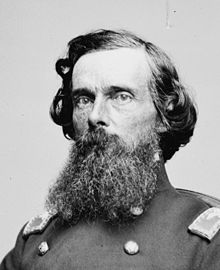User:Hreschk/Adams
Julius Walker Adams | |
|---|---|
 | |
| Born | October 18, 1812 |
| Died | December 13, 1899 (aged 87) |
| Resting place | Green-Wood Cemetery |
| Education | United States Military Academy |
| Occupation | |
| Board member of | American Society of Civil Engineers |
| Military career | |
| Allegiance | Union |
| Service | United States Army |
| Years of service | 1861–1862 |
| Rank | |
| Commands | 67th New York Infantry |
Julius Walker Adams (18 October 1812 – 13 December 1899) was a United States civil engineer, military leader, and railroad engineer, who designed the Starrucca Viaduct.[1]
Biography
[edit]Col Julius Walker Adams, the pioneer engineer of the Brooklyn Bridge, and commander of the 1st Regiment of the Long Island Volunteers, afterward the 69th New York, died at his home, No 155 Congress Street, Brooklyn, December 13 1899.
Col Adams, who was a second cousin of John Quincy Adams, was one of the most eminent and successful railway and bridge engineers of the century. Probably to him more than to any other one engineer is due the credit for the construction of the Brooklyn Bridge, which he partly planned in 1855. Col. Adams was born on October 18, 1812, of Revolutionary stock. He received his early education in Boston, his native city. He was appointed to the West Point, but left it before his graduation to follow his chosen profession of engineering. After he left West Point, in 1832, for three years he held the position of assistant engineer of the Stonington and Providence Railway. In the early part of 1835 he was the assistant engineer of the Paterson and Hudson River Railroad, and from March to November, 1835, he was an engineer in the service of the State of Indiana. From November 1835, to April 1836, he was the assistant engineer of the Norwich and Worcester Railroad, and from April, 1836, to October, 1836, he was the chief engineer of the Lawrenceburg and Indianapolis Railroad in Indiana. In the following year he served in the same capacity. He was successively connected with the United States service as chief engineer in the United States Coast Survey and the Connecticut River, chief engineer of the Lawrence and Niagara Falls Railroad, and assistant engineer of the United States for the survey of lighthouses.
From November, 1842, to October, 1844, he was the chief engineer of the Hudson River Railroad. Later he was the resident engineer of the Brooklyn Navy Yard, and engineer for the Boston Water Works. For three years from October, 1846, he was the superintending engineer of the New York and Erie Railway. Meanwhile he was the architect of several important public structures and private buildings. During the next several years he was the consulting engineer of the city of New York, Editor of "Appleton's Magazine," author of the "Dictionary of Engineering," of "Sewers and Drains for Populous Districts" (1880); and many scientific papers. From December, 1852, to July, 1855, he was engineer for the Lexington and Danville Railroad. He was later chief engineer for the Memphis and Ohio Railroad, engineer in charge of the Frankfort Bridge across the Kentucky River, and architect and builder of the Clay monument at Lexington, Kentucky. He designed the sewerage and drainage system for Brooklyn from 1857-60. In 1860 Adams was chief engineer of the New Haven Water Works and architect for the New York Institute for the Blind.
Military career
[edit]In 1860 Adams was colonel of the engineers of the second division of the New York State Militia. He was commissioned colonel of the 1st Regiment of the Long Island Volunteers in June, 1861, and served under General McClellan in the Army of the Potomac. He was appointed colonel of the 2d Hawkins Zouaves in November, 1862, and was in command of troops stationed in Printing House Square during the draft riots in 1863. Col. Adams was employed in various capacities as chief and consulting engineer on many of the important railroads of the United States from this time forward. From 1881 to 1882 he was Editor of "The Engineering News," and for the last fifteen years one of the esteemed collaborators of "The Sanitarian." He was the last of the twelve original founders of the American Society of Civil Engineers, and was a member of the New York Academy of Sciences, and also of the Association for the Advancement of Science. He was married in 1835, his wife dying in 1888. He leaves one daughter and one grandson. He lived in Brooklyn for fifty years.

